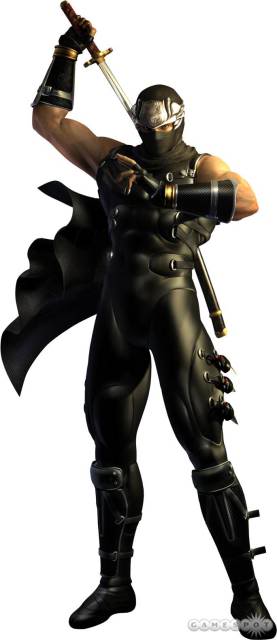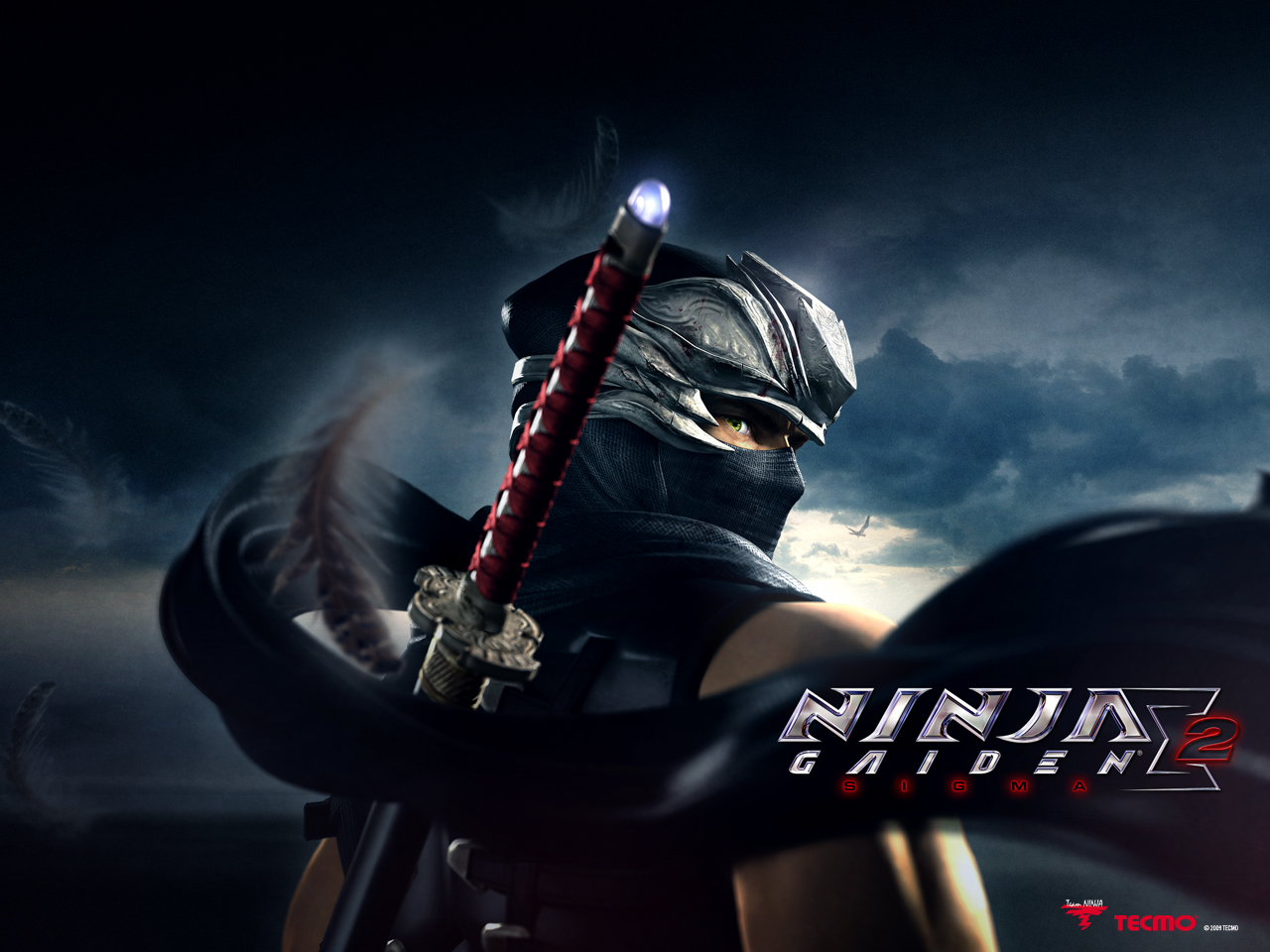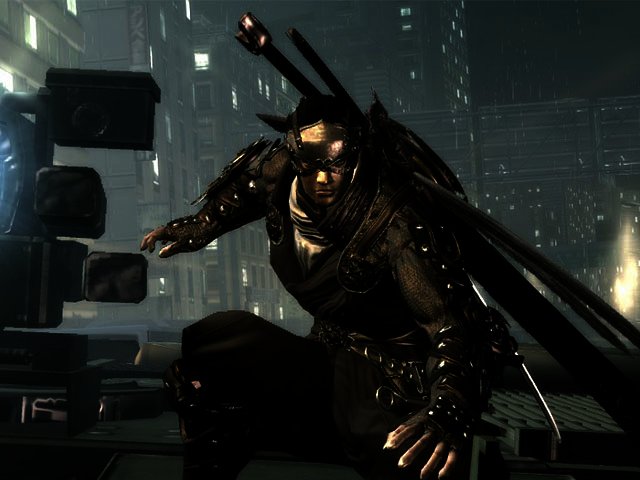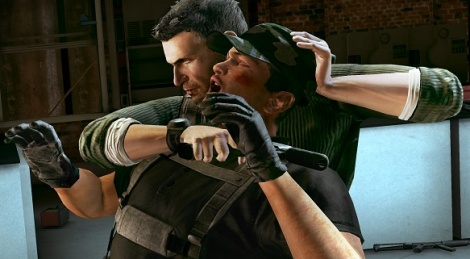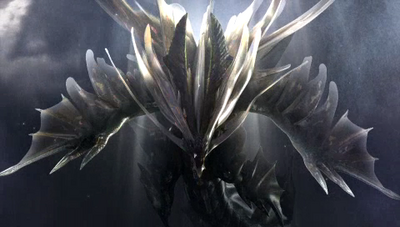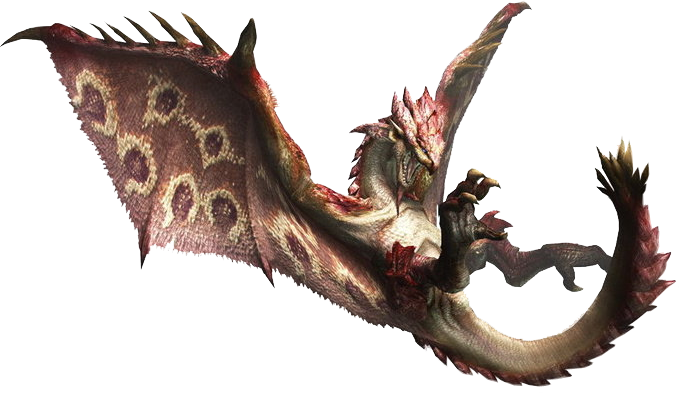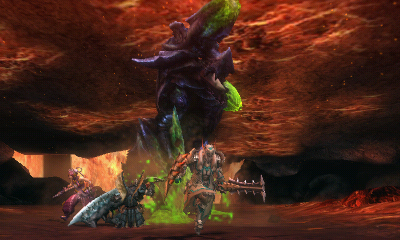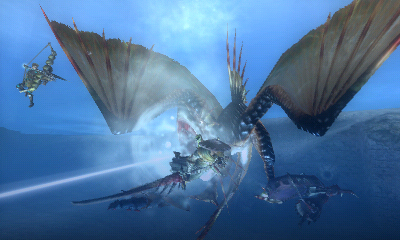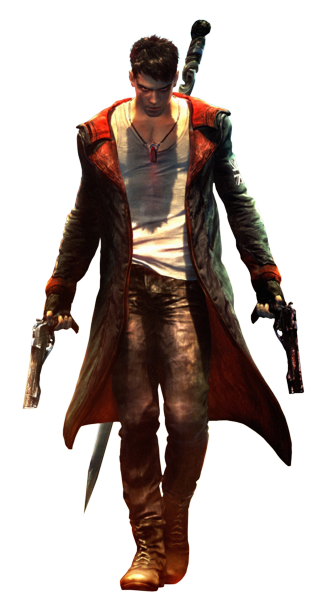Elder Dragons are unique creatures that are able to live in a variety of landscapes and have a long lifespan. Although named dragons, they don't all necessarily have four legs or wings. Some may be horse-like like the Kirin, or octopus-like like the Yama Tsukami because of their unnecessary fitting into any categories of monsters. There were only 3 Elder Dragons in the original Monster Hunter (Kirin, Lao-Shan Lung and Fatalis). In Monster Hunter 2, that amount was increased to 12. Most of the added Elder Dragons are very vulnerable at their sides, leading Capcom to add something extra like the wind barrier for the Kushala. A trait unique among Elder Dragons is that if they are injured by the hunter, they may flee to a different area. Elder Dragons are the most unique and often the most difficult to defeat. The Raviente, a new monster exclusive to Frontier, possesses features of the Lao Shan Lung, although it could be an entirely new species. The only Elder Dragons that have sub-species are Lao Shan Lung, Fatalis and Raviente. Teostra and Lunastra are not sub-species. They are both counter parts like Rathian and Rathalos. Compared with the normal Monster, the Elder Dragon is more enormous and powerfull and sometimes, they can't be killed in a single quest.
OK,,these are the Elder Dragons which appeared in Monster Hunter Universe:
1. Kirin
Kirin resemble white unicorns with their horn and their glowing white aura. It casts a pure white "shadow" under it at all times. The Kirin can summon lightning to strike attackers, or the area around it. The Kirin can be seen in the Tower, Snowy Mountains, Swamp, Old Swamp, Battlefield, and Old Jungle
Similarly to White Fatalis, Kirin's mane will continue to move or "flow" after its death. The Kirin has the least amount of carves of all the Elder Dragons, with only 2 carves being obtainable and nothing that can be broken off the Kirin for extra rewards. When it is close to death Kirin won't go into rage mode for a while, no matter how strong the attacks are.
In Monster Hunter Frontier Season 10.0, Kirin is considerably improved. It is surrounded by sparks of electricity at all times, is capable of performing a double back kick, a frontal flip that also releases a vast swathe of lightning, a charge so fast it almost seems to teleport and a huge array of new, powerful, and highly accurate lightning attacks
2. Lao Shan Lung/Ashen Lao Shan Lung
Lao-Shan Lung, or "Lao" are gigantic Elder Dragons popularly believed to be the size of a mountain. This giant, slow moving creature would go in hibernation until it's necessary to leave the area.
In Monster Hunter, Laos could only be fought online. The extremely hard scales on its back develops from the Lao walking directly through mountains. According to the Monster Hunter Freedom 2 info magazine, Lao Shan grows as his body receives floating particles from the atmosphere. The red tint comes from the iron deposits near their environment; the blue tint comes from ash particles from the Volcanic Belt. This process takes an untold amount of time, suggesting that Lao-Shan Lungs have extremely long life-spans.
The
Ashen Lao-Shan Lung is a subspecies of the Lao-Shan Lung. It is essentially the same creature, only possessing a different coloring and increased health. They typically migrate from volcanic areas in the time of season where the temperature becomes too hot to handle. The grey appearance of their massive scales is due to life long exposure to the ashes from volcanic eruptions rather than the iron-like particles found near Pokke village.
3. Fatalis/Crimson Fatalis/White Fatalis
Fatalis is the end-game Large Monster for Monster Hunter. He could only be fought online in the original Monster Hunter. The setting is at night in Castle Schrade. He is one of the three Elder Dragons in the original Monster Hunter, the others being Lao Shan-Lung and Kirin. The first of the Fatalis brethren
Crimson Fatalis, also known as
Red Fatalis, is a Black Fatalis whose shells and scales have become their reddish-crimson color after generations of exposure to the Volcano. Crimson Fatalis is the second of the Fatalis brethren and it lurks in the depths of the Volcanic Belt, where it lives as one with the environment
White Fatalis is the third of the Fatalis brethren. Like Kirin, the coat of a White Fatalis produces a bright white aura. It has the ability to call forth red lightning storms. Another trait that White Fatalis shares with Kirin is that when he is dead, his "mane" flows like it is still alive. The White Fatalis has an organ that can produce an "electric ball" that can be shot out from its mouth.
4. Chameleos
Chameleos is a large and poisonous chameleon-like Elder Dragon that has the ability to camouflage itself with invisibility almost all the time to blend the surroundings of Forest and Hills, Swamp and
Jungle as long as the horn and the tail remains. They have a hood on their neck similar to real-life cobras that might help them in their flight, as well as a leaf-shaped tail and horns that aid its camouflage.
5. Lunastra
Lunastra is a medium sized, blue-tinted, female counterpart of the Teostra. They commonly live in high cool Towers, and hot regions like the Volcanoes. Lunastra has also been spotted in the a Desert by a few hunters. Lunastra is the offline final boss for Monster Hunter 2
Lunastra, and their male version Teostra, are unique monsters because they actually use their Flame Sac to produce a fire breathing effect, rather than just a beam or a fireball. The Lunastra can produce a highly flammable powder and, by using its wings, spread it across the air. It then gnashes its teeth to create a spark, which then causes the powder around itself to ignite and explode. The explosions have random range; they can be either close, reasonably far away or very far away from where she's standing. If the sparks are red, then the explosions will be close, but if the sparks are yellow, then the explosions will be distant.
6. Teostra
The
Teostra is a male Elder Dragon whose distinct features are its large crimson mane and two curved horns. They are most often found in hot areas such as the Desert and the Volcano, but have been known to venture into the Swamp. Teostra, as well as its female counterpart Lunastra, have a dangerous fire aura that deals constant poison-like terrain damage to hunters standing nearby.
7. Kushala Daora/Rusted Kushala Daora
Kushala Daora is a wind-type Elder Dragon armed with a great variety of attacks: The Daora's most common element-based attack is its wind breath that can freeze the hunter if it is in the Snowy Mountains. Other living habitats include the Jungle, Desert and the Town. Kushala Daora is the flagship monster of Monster Hunter 2 and appears in the opening movie and cover of the box. A typical Kushala has silver-colored skin constructed of a unique ore grown naturally by the Dragon. The rarer Kushala is one whose metalic skin has rusted to form a dark brown/red crust covering the skin. This skin is (at a later date) shed in a similar fashion to that of snakes, to reveal a softer shinier grey. Hunters usually fight their first Kushala in the 4* Elder Quests (The Frozen Dictator)
The
Rusted Kushala Daora is an older Kushala Daora that hasn't shed its metallic scales recently. In response, its shiny, silver, metallic skin becomes a rusted brown. It can be fought in a download quest in Monster Hunter Freedom 2, and in the Gathering Hall (Quest Level 5, only able to start Quest if players has completed all HR2 and 3 Quests). Both of these Quests happen in the Town. In Monster Hunter Freedom Unite, it fights the same as a Kushala Daora and has the same carves. It should be noted that when hunters fight it, there is no storm, so all Barrel Bombs can be used. The head crest will only break when the Rusted Kushala Daora reaches 60% health
8. Yama Tsukami
Yama Tsukami are amongst the oldest creatures known to hunters. Their skin is covered by Dragonmoss and Dragonwood. They have four tentacles and a pair of 'whiskers'. They also drop Dragonwood and Dragonmoss as rewards. When enraged, their red eyes glow yellow.
Their classification as an Elder Dragon is simply due to the fact that they do not fit into any category, like the
Kirin. This mysterious creature's place in relation to other monsters is completely unknown. Although of tremendous size, it is able to constantly stay up in the air with no support. Their attacks are slow but devastating.
They seem to have a symbiotic relationship with Great Thunderbugs, which lets them rest inside a Yama Tsukami's body until they mature. In return, the Great Thunderbugs assist them by attacking Hunters. These Thunderbugs can explode when they are near a Hunter, causing a good amount of damage to their target.
9. Ceadeus
Ceadeus is an extremely large, whale-like Elder Dragon that first appeared in Monster Hunter 3. It resides in a series of underwater canyons and ruins deep below Moga Island, but is unable to travel onto land. Ceadeus is the end-game boss in the offline campaign.
Ceadeus' right horn is much thicker than its left and halfway envelops its right eye. It can be broken off and carved twice. Its neck resembles Lagiacrus' hood-like structure, but with a large fur coat underneath. This 'beard' can be broken and its hood and tail scarred. The quest can be taken multiple times, with Ceadeus unable to recover its health between quests. Eventually, once enough damage has been dealt, it will be killed.
Ceadeus is the first monster players fight able to inflict Dragonblight, a status effect that decreases affinity for a fixed amount of time before disappearing. Other monsters capable of inflicting this ailment include Deviljho and Alatreon, and it is unique to monsters with the dragon element. Ceadeus has its own Sword and Shield, Great Sword, Long Sword, and Switch Axe.
10. Jhen Mohran
Jhen Mohran is a huge monster found in Monster Hunter 3 and in Monster Hunter Portable 3rd. In Monster Hunter 3, Jhen Mohran can only be fought online, but it can be fought in both the Village and Guild quests in Monster Hunter Portable 3rd. It lives only in the Great Desert.The first time the players can encounter this monster is in a HR30 Urgent Quest called "The Festival Of Fear". It is also available in two event quests.
The people of Loc Lac have a festival when it comes. The Guild master hires hunters to kill it so they can mine unique ore found exclusively on its body.
11. Alatreon
Alatreon, sometimes referred to as the "Glittering Black Dragon" is a fierce Elder Dragon living in a volcano region called the Sacred Land. It is the final end-game boss online in Monster Hunter 3. Alatreon is elementally unstable, possessing control over the Dragon, Fire, Thunder, and Ice elements. When weakened, Alatreon will fly high into the air and rain down ice crystals. Some ice crystals fall on random spots while others may target certain players. Alatreon will only use the Ice and Thunder elements while in the air. It is said that it has the abilities of all the True Elder Dragons (Kushala Daora, Chameleos, Lunastra and Teostra), although, since it is elementally unstable, it is unable to truly harness that power.
Alatreon does return in MHP3rd, with some new attacks, such as a double horn thrust, as well as better-harnessing its elemental control. Now it is able to call down Lightning to strike the hunter, much like the White Fatalis, both on the ground or in the air. When it is about to perform this attack, its horns will glow blueish-white. Its colors are also more pronounced when it is using the various elements. There are also violent storms around the Sacred Land area in MHP3rd.
12. Amatsumagatsuchi
The final boss for Monster Hunter Portable 3rd. It spends most of the time airborne and is capable of unleashing devastating beams of concentrated wind and water. It seems to possess the ability to manipulate storms and wind, as it is surrounded by a hurricane wherever it goes. It has been sighted above the Mountain Stream, attacking an airship manned by a Hunter and his comrades.
In battle, Amatsumatgatsuchi hovers above the ground. Its movements are reminiscent of fighting the Leviathans underwater in Monster Hunter Tri, and many of its attacks are similar to those used by them, such as the charge, tail whip, and roar animations. He also has a wind barrier around his body, though it doesn't cause the hunter or attacks to be deflected, unlike Kushala Daora's wind barrier. However, Ballista shots will be somewhat less effective as long as the barrier remains active. The barrier is somewhat less stable than Kushala Daora's, as it temporarily disappears when Amatsumagatsuchi uses certain attacks.
When angered, his eyes begin to glow, and when Amatsumagatsuchi is damaged enough, it will enter a second state of rage: its horns will shine in a golden glow and the whole body will be covered with purple markings as the storm around it intensifies. (The second part of the theme will begin playing as well.) This second rage state means that Amatsumagatsuchi will become far more aggressive and use its most powerful attacks, but unlike White Fatalis and its armor mode, its head will take
more damage instead of less (the defense of all of its other parts remains the same).
One of its most dangerous attacks is when it creates a small twister that begins to suck in the hunter, then hits them hard with a tornado-shrouded charge. Even if the first main twister is avoided, he will revolve around the second twister, encompassing a wider area with every revolution. If the hunter is close enough when hit, it will cause him/her to fly back into the twister. The second twister will remain on the field for several seconds before disappearing and can still damage the hunter.
When weakened enough, Amatsumagatsuchi uses its other most powerful move: it flies high into the air and uses three massive water beams. The attack consists of two parts; the beams themselves will strike the ground, and then the areas where the ground was struck explodes with water.
13. Raviente/Raviente Subspecies
Raviente is a monster first featured in the Monster Hunter Frontier 7.0 Update. Raviente is a giant, tusked serpent living on a lonely island far from civilization. It can burrow both underground and underwater. Raviente's roar is on a whole other level unlike any seen before, requiring a skill larger than High Grade Earplugs to block.Raviente primarily attacks by smashing its face into the ground causing an array of flying rocks. Because of the succession of these hits, hunters caught in the vicinity will become knocked out (dizzy). Once in awhile, Raviente will become stuck into the ground for roughly 15 seconds, becoming vulnerable. It has many devastating attacks like its gigantic fireballs, but Raviente will deeply inhale before releasing them, giving ample warning. The various islands in which it is fought have green spots that randomly appear on the ground, and by standing on these, you will recieve a health boost; however, there are also darker, brownish spots which slowly sap away your health when you step on them.
Raviente can release a powder that ignites, much like the Teostra. After burrowing into the ground, there will be a series of volcanic geyser eruptions similar to Akantor's fire pillars, except that it takes a bit longer before it explodes. Stepping onto the fire area decreases hunters health. It is also capable of apparently summoning a hail of meteor-like rocks to bound across the field, although they may be a coincidental natural occurrence. It appears to be the largest monster in the Monster Hunter universe thus far.
The color variant of Raviente, released as part of the latest update to Monster Hunter Frontier, Monster Hunter Frontier Season Forward 1. Instead of a reddish shell it is white, with green eyes and a more muted shell and fins.
It seems to inhabit Geyser Island, and to have a whole new set of moves, including the ability to roar while its head is stuck in the ground, causing rocks or water to splash all over the area. Raviente Subspecies also has a new move where it digs and resurfaces faster than an ordinary Raviente, a large tail slam, the ability to suck wind using its mouth, and roaring on the Volcano to cause volcanic rocks to fall over the hunters below.
Also, unlike the previous normal Raviente hunts, new weapons like Balloons, Felyne Ballistas, geyser bombs, Underground Sonic Bombs and more weapons can be used against Raviente Subspecies. The weapons' effect are as follows:
- Underground Sonic Bombs can unearth Raviente Subspecies while it is underground.
- With Felyne Ballista, Felynes with a Ballista Bowgun pop up and fire Ballista Shots at Raviente Subspecies.
- Geyser Bombs can be placed on Geysers to fire at Raviente Subspecies.
These weapons seems to be bought from a man at the base camp.
14. Rukodiora
Rukodiora is a new Elder Dragon featured in the newest update of Monster Hunter Frontier, Monster Hunter Frontier Season Forward 1. It inhabits a new Fort type area, the Interceptor's Base, to which it is laying siege. Its Japanese name 極龍 means Magnetic Dragon. It shares the same general build as other Elder Dragons. It has large gold colored horns that can be broken three times, golden wings, grey scales, and spines along its tail. A dark circle, along with boulders and other debris surrounds Rukodiora.
When attacking, Rukodiora uses the levitating debris around it to throw at hunters. It also uses its claws to swipe at the hunter, releases elemental balls and has a sweeping beam. It also appears to manipulate magnetism in a complex way while its magnetic rings allows it to manipulate polar magnetism when it is in rage mode. It first inflicts the status through contact with any of its red attacks or through an orange 'dust' from its wings. When its ring flashes red, anyone who is magnetised will be drawn to Rukodiora. When its ring pulses blue, the magnetic attraction ceases, however, it in turn allows it to inflict its status again.
Rukodiora can be paralyzed but can still move around while paralyzed, unlike most of the previous monsters that remain in one place. Rukodiora is also susceptible to Poison, Sleep, Flash Bombs, and KO with Impact attacks. When its tail is cut off or horn is broken, it will temporarly lose its magnetic ability.
Source: http://monsterhunter.wikia.com



